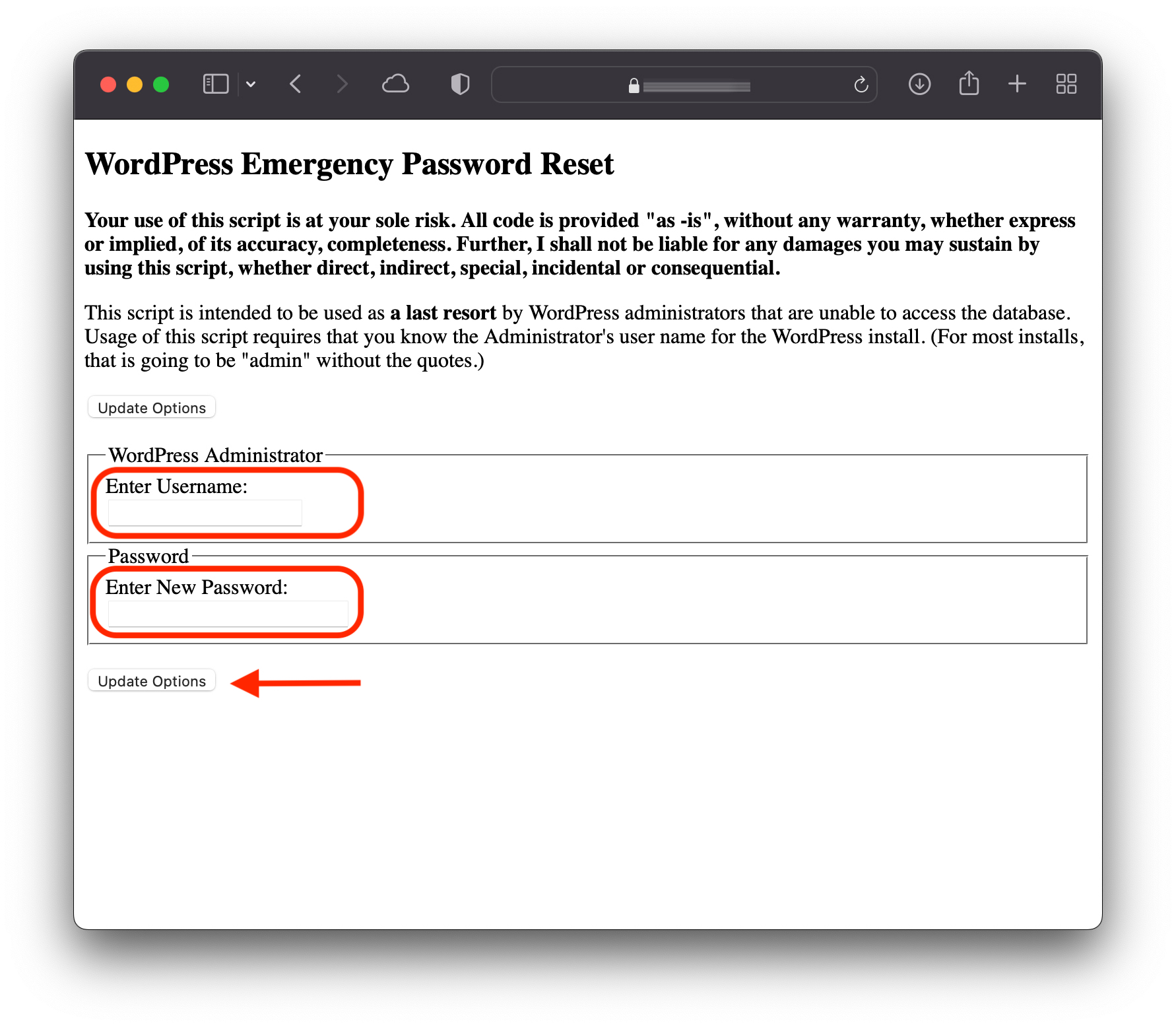Υπάρχουν επίσης κρίσιμες στιγμές που για διάφορους λόγους δεν έχουμε πλέον πρόσβαση στη διεύθυνση email στην οποία καταχωρήσαμε τον χρήστη μας. Administrator WordPress, δεν γνωρίζουμε πλέον τα διαπιστευτήρια πρόσβασης στη βάση δεδομένων και δεν θυμόμαστε καν τον κωδικό πρόσβασης του χρήστη διαχείρισης. Σε αυτό το σενάριο πρέπει να βρούμε μια λύση πώς να επαναφέρουμε τον κωδικό πρόσβασης χρήστη Administrator WordPress. Reset WordPress Administrator Password.
Metotda παρακάτω, από επαναφέρετε τον κωδικό πρόσβασης ενός χρήστη WordPress απαιτεί πρόσβαση στο FTP ή σε έναν διαχειριστή αρχείων (μέσω cPanel) για τη δημιουργία ενός αρχείου στον ριζικό φάκελο όπου είναι εγκατεστημένο το ιστολόγιο ή ο ιστότοπος με WordPress για το οποίο θέλουμε να ανακτήσουμε τον κωδικό πρόσβασης διαχειριστή.
Καμπίνα
Πώς να επαναφέρετε τον κωδικό πρόσβασης χρήστη Administrator WordPress εάν δεν έχουμε πρόσβαση σε email ή βάση δεδομένων
Reset WordPress Administrator Password
1. Δημιουργούμε στον κεντρικό διακομιστή του WordPress στον ριζικό φάκελο (public_htmlένα αρχείο PHP (reset_password.php, για παράδειγμα) στο οποίο προσθέτουμε τον παρακάτω κώδικα:
<?php
/*
This program is free software; you can redistribute it and/or modify
it under the terms of the GNU General Public License as published by
the Free Software Foundation; either version 2 of the License, or
(at your option) any later version.
This program is distributed in the hope that it will be useful,
but WITHOUT ANY WARRANTY; without even the implied warranty of
MERCHANTABILITY or FITNESS FOR A PARTICULAR PURPOSE. See the
GNU General Public License for more details.
You should have received a copy of the GNU General Public License
along with this program; if not, write to the Free Software
Foundation, Inc., 59 Temple Place, Suite 330, Boston, MA 02111-1307 USA
*/
require './wp-blog-header.php';
function meh() {
global $wpdb;
if ( isset( $_POST['update'] ) ) {
$user_login = ( empty( $_POST['e-name'] ) ? '' : sanitize_user( $_POST['e-name'] ) );
$user_pass = ( empty( $_POST[ 'e-pass' ] ) ? '' : $_POST['e-pass'] );
$answer = ( empty( $user_login ) ? '<div id="message" class="updated fade"><p><strong>The user name field is empty.</strong></p></div>' : '' );
$answer .= ( empty( $user_pass ) ? '<div id="message" class="updated fade"><p><strong>The password field is empty.</strong></p></div>' : '' );
if ( $user_login != $wpdb->get_var( "SELECT user_login FROM $wpdb->users WHERE ID = '1' LIMIT 1" ) ) {
$answer .="<div id='message' class='updated fade'><p><strong>That is not the correct administrator username.</strong></p></div>";
}
if ( empty( $answer ) ) {
$wpdb->query( "UPDATE $wpdb->users SET user_pass = MD5('$user_pass'), user_activation_key = '' WHERE user_login = '$user_login'" );
$plaintext_pass = $user_pass;
$message = __( 'Someone, hopefully you, has reset the Administrator password for your WordPress blog. Details follow:' ). "\r\n";
$message .= sprintf( __( 'Username: %s' ), $user_login ) . "\r\n";
$message .= sprintf( __( 'Password: %s' ), $plaintext_pass ) . "\r\n";
@wp_mail( get_option( 'admin_email' ), sprintf( __( '[%s] Your WordPress administrator password has been changed!' ), get_option( 'blogname' ) ), $message );
$answer="<div id='message' class='updated fade'><p><strong>Your password has been successfully changed</strong></p><p><strong>An e-mail with this information has been dispatched to the WordPress blog administrator</strong></p><p><strong>You should now delete this file off your server. DO NOT LEAVE IT UP FOR SOMEONE ELSE TO FIND!</strong></p></div>";
}
}
return empty( $answer ) ? false : $answer;
}
$answer = meh();
?>
<!DOCTYPE html PUBLIC "-//W3C//DTD XHTML 1.0 Transitional//EN" "http://www.w3.org/TR/xhtml1/DTD/xhtml1-transitional.dtd">
<html xmlns="http://www.w3.org/1999/xhtml">
<head>
<title>WordPress Emergency Password Reset</title>
<meta http-equiv="Content-Type" content="<?php bloginfo( 'html_type' ); ?>; charset=<?php bloginfo( 'charset' ); ?>" />
<link rel="stylesheet" href="<?php bloginfo( 'wpurl' ); ?>/wp-admin/wp-admin.css?version=<?php bloginfo( 'version' ); ?>" type="text/css" />
</head>
<body>
<div class="wrap">
<form method="post" action="">
<h2>WordPress Emergency Password Reset</h2>
<p><strong>Your use of this script is at your sole risk. All code is provided "as -is", without any warranty, whether express or implied, of its accuracy, completeness. Further, I shall not be liable for any damages you may sustain by using this script, whether direct, indirect, special, incidental or consequential.</strong></p>
<p>This script is intended to be used as <strong>a last resort</strong> by WordPress administrators that are unable to access the database.
Usage of this script requires that you know the Administrator's user name for the WordPress install. (For most installs, that is going to be "admin" without the quotes.)</p>
<?php
echo $answer;
?>
<p class="submit"><input type="submit" name="update" value="Update Options" /></p>
<fieldset class="options">
<legend>WordPress Administrator</legend>
<label><?php _e( 'Enter Username:' ) ?><br />
<input type="text" name="e-name" id="e-name" class="input" value="<?php echo attribute_escape( stripslashes( $_POST['e-name'] ) ); ?>" size="20" tabindex="10" /></label>
</fieldset>
<fieldset class="options">
<legend>Password</legend>
<label><?php _e( 'Enter New Password:' ) ?><br />
<input type="text" name="e-pass" id="e-pass" class="input" value="<?php echo attribute_escape( stripslashes( $_POST['e-pass'] ) ); ?>" size="25" tabindex="20" /></label>
</fieldset>
<p class="submit"><input type="submit" name="update" value="Update Options" /></p>
</form>
</div>
</body>
</html>
<?php exit; ?>2. Ανοίξτε στο πρόγραμμα περιήγησης τη διεύθυνση web στην οποία βρίσκεται το νέο αρχείο: https://example.com/reset_password.php και στα δύο πεδία εισάγουμε τον χρήστη του Administrator και τον νέο κωδικό πρόσβασης και μετά κάντε κλικ στο "Update Options"

3. Αφού κάνετε κλικ στην ενημέρωση κωδικού πρόσβασης (Update Options), στο email του χρήστη με τον βαθμό του administrator για το οποίο έχετε κάνει επαναφορά, θα σταλεί μήνυμα με τον νέο κωδικό της επιλογής σας.
4. Διαγράψτε αμέσως το αρχείο από τον διακομιστή. Μπορεί να χρησιμοποιηθεί από οποιονδήποτε χρήστη.
Your password has been successfully changed
An e-mail with this information has been dispatched to the WordPress blog administrator
You should now delete this file off your server. DO NOT LEAVE IT UP FOR SOMEONE ELSE TO FIND!
Αυτή είναι η πιο απλή και αποτελεσματική μέθοδος reset WordPress Administrator password, για το σενάριο στο οποίο δεν έχετε πρόσβαση στη βάση δεδομένων ή στον λογαριασμό e-mail στον οποίο μπορείτε να ανακτήσετε τον κωδικό πρόσβασής σας.